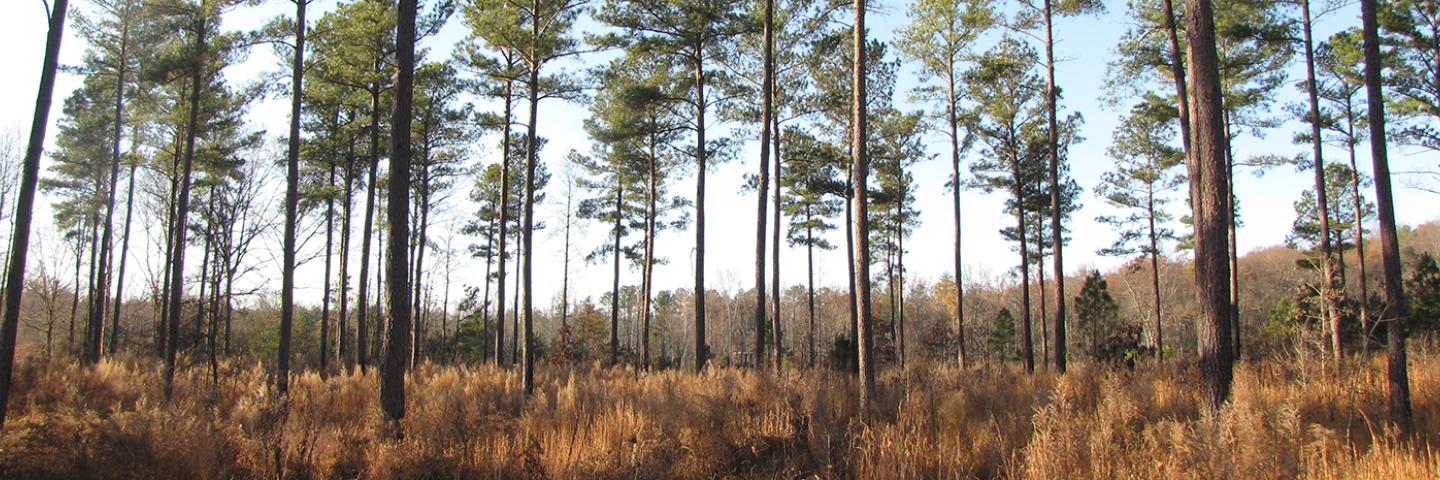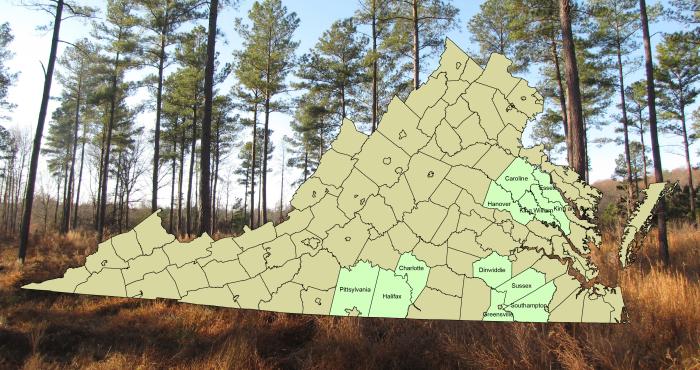Notice


The northern bobwhite is a state-identified target species of the Working Lands for Wildlife (WLFW) partnership, a collaborative approach to conserve habitat on working lands. This project is designed to help bring back the quail that were once an integral part of Virginia’s farming way of life.
State Program Overview
The ecologically rich system of pine savannas supports diverse wildlife ranging from common large game animals to rare and declining species such as the northern bobwhite quail, field sparrow, prairie warbler, and red-cockaded woodpecker. Once a major ecosystem in the Southeast United States, most savannas have been harvested and converted to more intensive loblolly production.
Research shows that closed canopy/unburned pine stands provide poor quality habitat for bobwhites and other key species. NRCS offers technical and financial assistance through the Environmental Quality Incentives Program (EQIP) to help Virginia forest landowners convert commercial loblolly and shortleaf pine plantings to highly valuable pine savanna habitats with relatively simple changes in management strategies.
Focal Area
Virginia is conducting targeted habitat restoration activities throughout the state with a focus on the following wildlife focal counties in pine-dominated landscapes: Caroline, Charlotte, Dinwiddie, Essex, Greensville, Halifax, Hanover, King & Queen, King William, Pittsylvania, Southampton, and Sussex (see map below):

Assistance Available
NRCS offers technical assistance and incentive payments for planning and installing practices with the potential to drastically increase the amount of pine savanna habitats in Virginia [i.e., thinning (≤50 ft2/acre basal area), follow-up spraying of undesirable woody species and prescribed burning].
- 314 - Brush Management
- 647 - Early Successional Habitat Management
- 394 - Firebreak
- 666 - Forest Stand Improvement
- 422- Hedgerow Planting
- 315 - Herbaceous Weed Control
- 338 - Prescribed Burning
- 612 - Tree/Shrub Establishment
Outcomes and Impacts
Participants can benefit from the sale of forest products, offset costs of habitat management and an increase in wildlife viewing opportunities and recreational activities. Meanwhile, the wildlife will positively respond to the newly available habitat, often with increased numbers of species such as the northern bobwhite, brown-headed nuthatch, field sparrow and prairie warbler.
State Contacts:
Jeff Jones, State Biologist
PH: 804-287-1636 | Email: jeffray.jones@usda.gov
Field Offices Serving Focal Counties
Charlotte CH (Charlotte) – 434-542-5442, ext. 3
Chatham (Pittsylvania) – 434-432-3061
Courtland (Southampton) – 757-653-2532, ext. 3
Dinwiddie (Dinwiddie) – 804-469-7297
Emporia (Greensville and Sussex) – 434-634-2115
Halifax (Halifax) – 434-266-3100
Hanover (Caroline and Hanover) – 804-537-3008
Tappahannock (Essex, King & Queen, and King William) – 804-466-3188
Ready to get started?
Contact your local service center to start your application.
How to Get Assistance
Do you farm or ranch and want to make improvements to the land that you own or lease?
Natural Resources Conservation Service offers technical and financial assistance to help farmers, ranchers and forest landowners.

To get started with NRCS, we recommend you stop by your local NRCS field office. We’ll discuss your vision for your land.
NRCS provides landowners with free technical assistance, or advice, for their land. Common technical assistance includes: resource assessment, practice design and resource monitoring. Your conservation planner will help you determine if financial assistance is right for you.
We’ll walk you through the application process. To get started on applying for financial assistance, we’ll work with you:
- To fill out an AD 1026, which ensures a conservation plan is in place before lands with highly erodible soils are farmed. It also ensures that identified wetland areas are protected.
- To meet other eligibility certifications.
Once complete, we’ll work with you on the application, or CPA 1200.
Applications for most programs are accepted on a continuous basis, but they’re considered for funding in different ranking periods. Be sure to ask your local NRCS district conservationist about the deadline for the ranking period to ensure you turn in your application in time.
As part of the application process, we’ll check to see if you are eligible. To do this, you’ll need to bring:
- An official tax ID (Social Security number or an employer ID)
- A property deed or lease agreement to show you have control of the property; and
- A farm number.
If you don’t have a farm number, you can get one from USDA’s Farm Service Agency. Typically, the local FSA office is located in the same building as the local NRCS office. You only need a farm number if you’re interested in financial assistance.
NRCS will take a look at the applications and rank them according to local resource concerns, the amount of conservation benefits the work will provide and the needs of applicants. View Application Ranking Dates by State.
If you’re selected, you can choose whether to sign the contract for the work to be done.
Once you sign the contract, you’ll be provided standards and specifications for completing the practice or practices, and then you will have a specified amount of time to implement. Once the work is implemented and inspected, you’ll be paid the rate of compensation for the work if it meets NRCS standards and specifications.

